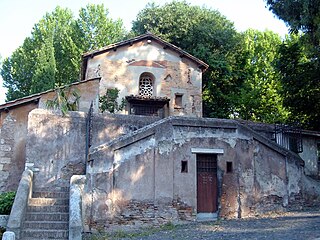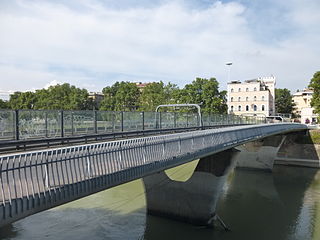
Campo Marzio is the 4th rione of Rome, Italy, identified by the initials R. IV. It belongs to the Municipio I and covers a smaller section of the area of the ancient Campus Martius. The logo of this rione is a silver crescent on a blue background.

The Via Giulia is a street of historical and architectural importance in Rome, Italy, which runs along the left (east) bank of the Tiber from Piazza San Vincenzo Pallotti, near Ponte Sisto, to Piazza dell'Oro. It is about 1 kilometre long and connects the Regola and Ponte Rioni.

The Magliana is an urban zone of Rome, known as 15E of Municipio XI of Rome. It also the name of a neighborhood or ward of the city. Geographically, it is located on the southwest periphery of Rome, Italy along the Tiber River. The neighborhood dates back to the mid-1900s and is home to a diverse group of people of all ages and ethnicities. About 40,000 people reside in Magliana; housing is made up of mostly owner-occupied apartments in 7–8 story apartment buildings.

Ponte Galeria is the 41st zona of Rome, Italy, identified by the initials Z. XLI. Geographically it was part of Agro Romano. The zone belongs to the Municipio XI.

Corso Vittorio Emanuele II, commonly known as Corso Vittorio, is a wide east–west thoroughfare that courses through Rome. It connects a bridge over the Tiber, Ponte Vittorio Emanuele II, to both the Via Torre Argentina and Via del Plebiscito. The latter Via continues east from Piazza del Gesù and along Palazzo Venezia to reach Piazza Venezia which sits below the massive white Monument to Vittorio Emanuele II.

Lungotevere is an alley or boulevard running along the river Tiber within the city of Rome. The building of the Lungoteveres required the demolition of the former edifices along the river banks and the construction of retaining walls called muraglioni.

The Lungotevere Maresciallo Diaz is the stretch of Lungotevere that links Piazza Lauro De Bosis to Piazzale di Ponte Milvio, in Rome (Italy), in the Quarter Della Vittoria.

Ponte Regina Margherita, also known as Ponte Margherita, is a bridge linking Piazza della Libertà to Lungotevere Arnaldo da Brescia, in the rioni Campo Marzio and Prati in Rome, Italy.

Ponte Umberto I, also known as Ponte Umberto, is a bridge that links Piazza di Ponte Umberto I to Piazza dei Tribunali in Rome (Italy), in the rioni Ponte and Prati.

Ponte Palatino, also known as Ponte Inglese, is a bridge that links Lungotevere Aventino to Lungotevere Ripa in Rome (Italy), in the Rioni Ripa and Trastevere.

Portuense is the 11th quartiere of Rome (Italy), identified by the initials Q.XI.
Lungotevere della Magliana is the stretch of the urban road along the Tiber that connects via del Ponte della Magliana to via della Magliana, in Rome's Portuense district.

Lungotevere Tor di Nona is the stretch of Lungotevere that connects Piazza di Ponte Sant'Angelo to Piazza di Ponte Umberto I in Rome, in the rione Ponte. It was named so following the resolution of the city council of 20 July 1887.

The following outline is provided as an overview of and topical guide to Rome:

The Rome–Fiumicino railway is an urban railway line in Rome.

Ponte Morandi, officially Viadotto Polcevera, was a road viaduct in Genoa, Liguria, Italy, constructed between 1963 and 1967 along the A10 motorway over the Polcevera River, from which it derived its official name. It connected Genoa's Sampierdarena and Cornigliano districts across the Polcevera Valley. The bridge was widely called "Ponte Morandi" after its structural designer, engineer Riccardo Morandi.

The Fontana or Fontanone di Ponte Sisto, once known as the Fontanone dei Cento Preti, is an early 17th-century, monumental fountain now located in Piazza Trilussa, facing the south end of the Ponte Sisto, in Trastevere, Rome, Italy. It was reconstructed here in the late 19th century, originally erected across the river, attached to the former building of the Collegio Ecclesiastico.

Ponte Pietro Nenni is a bridge crossing the Tiber in Rome, which connects lungotevere Arnaldo da Brescia and lungotevere Michelangelo, in the Quarter Flaminio and Rione Prati respectively.

Ponte Flaminio is a bridge in Rome (Italy), crossed by Corso di Francia, in the Quartieri Parioli and Tor di Quinto and in the zone of Vigna Clara.



















